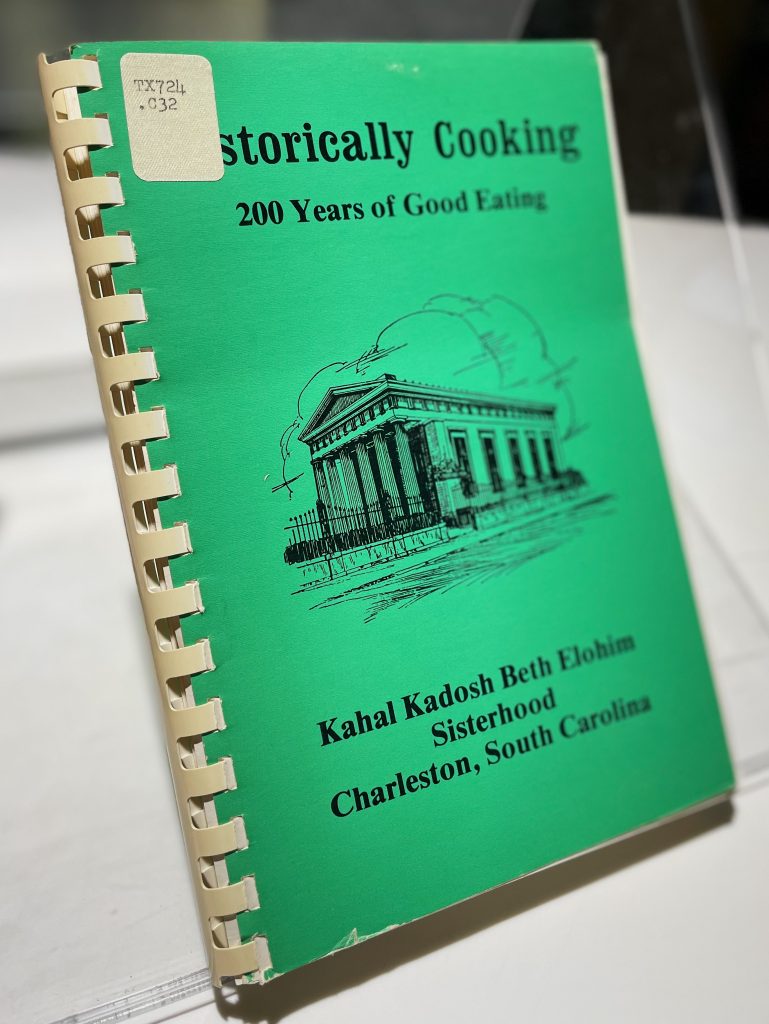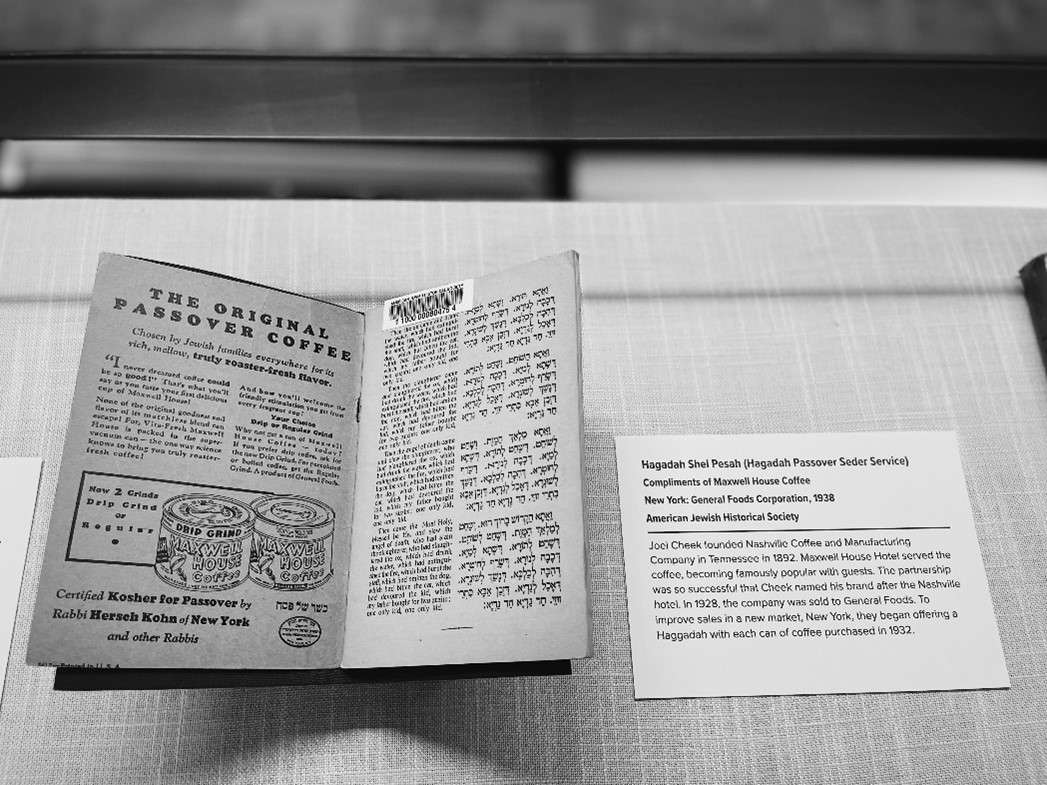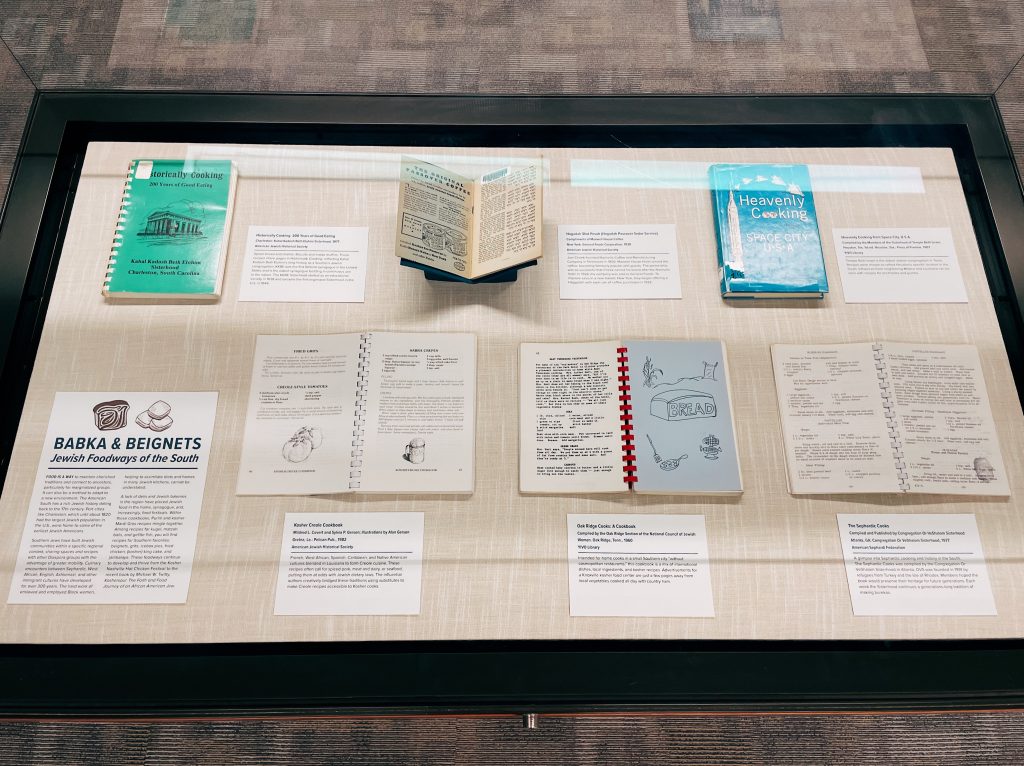By Cassia Kisshauer
Reference Services Librarian, Center for Jewish History
Babka & Beignets: Jewish Foodways of the South
Food is a way to maintain cherished traditions and connect to ancestors, particularly for marginalized groups. It can also be a method to adapt to a new environment. The American South has a rich Jewish history dating back to the 17th century. Port cities like Charleston, which until about 1820 had the largest Jewish population in the U.S., were home to some of the earliest Jewish Americans.
Southern Jews have built Jewish communities within a specific regional context, sharing spaces and recipes with other Diaspora groups with the advantage of greater mobility. Culinary encounters between Sephardic, West African, French, English, Ashkenazi, and other immigrant cultures have developed for over 300 years. Many Jews ate what was affordable and available, including Southern staples like grits, collards, and red beans and rice. The hard work of enslaved and employed Black women, helping to assimilate diets and homes in many Jewish kitchens, cannot be understated. That proximity of work in the kitchen would have been much closer for families and synagogues that remained strictly kosher than for their Christian neighbors. 1
A lack of delis and Jewish bakeries in the region have placed Jewish food in the home, synagogue, and, increasingly, food festivals. This has made community cookbooks created by Southern Jews with Southern Jews in mind fantastic resources. Within Southern cookbooks, Purim and Mardi Gras recipes mingle together. Among recipes for kugel, matzoh balls, and gefilte fish, you will find recipes for Southern favorites: beignets, grits, icebox pies, fried chicken, king cake, and jambalaya. These foodways continue to develop and thrive, from the Kosher Nashville Hot Chicken Festival to the recent, award-winning book by Michael W. Twitty, Koshersoul: The Faith and Food Journey of an African American Jew.
“What does Southern Jewish food taste like? The best answer I can give is, it takes like we’re going to be okay… [Southern Jewish foods] bring me back to a centered place for myself where I can reconnect to my family, to the people who raised me up.” -Dr. Marcie Cohen Ferris 2

A glimpse into Sephardic cooking and history in the South, The Sephardic Cooks [above] was compiled in 1982 by the Sisterhood of Congregation Or VeShalom (OVS) in Atlanta. OVS was founded in 1914 by refugees from Turkey and the Isle of Rhodes. Members hoped the book would preserve their Sephardic heritage for future generations and encourage the preparation of the recipes that were passed down. The book was so successful that new editions continue to be published. The Sisterhood also continues the generations-long tradition of making burekas by hand each week while speaking Ladino together to build community, sustain traditions, and raise funds for the synagogue.3

French, West African, Spanish, Caribbean, and Native American cultures blended in Louisiana to form Creole cuisine. These cultural interactions began in the colonial period and have continued to develop today. Recipes often call for spiced pork, meat and dairy combined, or seafood, putting them at odds with Jewish dietary laws. Mildred Covert and Sylvia Gerson, the influential New Orleanian authors, creatively bridged these traditions in the Kosher Creole Cookbook [above] using substitutes to make Creole recipes accessible to Kosher cooks. Published in 1982, the book moves through the year starting in September, providing kosher-friendly seasonal menus with Louisiana favorites from jambalaya to beignets.

Spoon bread and challah. Biscuits and matzo muffins. These recipes share pages in Historically Cooking: 200 Years of Good Eating [above], reflecting Kahal Kadosh Beth Elohim’s (KKBE) history as a prominent Southern Jewish congregation since 1749. Jews began settling in Charleston in 1695, and by 1800 South Carolina had the largest Jewish population of any state. KKBE was the first Reform synagogue in the United States and is the oldest synagogue building in continuous use in the nation. The KKBE Sisterhood started as an educational society in 1838 and became the first organized Sisterhood in the U.S. in 1844.

Published in 1960 and intended for home cooks in a small Southern city “without cosmopolitan restaurants,” Oak Ridge Cooks: A Cookbook Compiled by the Oak Ridge Section of the National Council of Jewish Women [above] is a mix of international dishes, local ingredients, and kosher recipes. Recipes were selected with dinner parties and other home-based social events in mind. Advertisements for Knoxville’s kosher food center are just a few pages away from a recipe for East Tennessee vegetables cooked all day with country ham.

Temple Beth Israel is the oldest Jewish congregation in Texas. Recipes in Heavenly Cooking from Space City, U.S.A. [above], which was compiled by the temple’s sisterhood in 1967, were chosen to reflect Houston’s specific location in the South. Influences from neighboring Mexico and Louisiana can be seen with recipes for enchiladas and gumbo.

One popular Haggadah that has even been used in White House seders has ties to Southern food and drink manufacturing. Joel Cheek founded Nashville Coffee and Manufacturing Company in Tennessee in 1892. Maxwell House Hotel was one of his first big customers. The coffee became famously popular with customers, including rumors of President Roosevelt’s approval-turned-slogan that it was “good to the last drop.” The partnership was so successful that Cheek named his brand after the Nashville hotel. In 1928, the company was sold to General Foods. In 1932, to improve sales in a new market, New York, they began offering a Haggadah [above] with each can of coffee purchased, and these remained a staple of American seders well into the 21st century.
Books on exhibit in the Lillian Goldman Reading Room through mid-March 2023:
Hagadah Shel Pesaḥ (Hagadah Passover Seder Service) / Compliments of Maxwell House Coffee. New York: General Foods Corporation, 1938. Collection of the American Jewish Historical Society.
Heavenly Cooking from Space City, U.S.A., / Compiled by the Members of the Sisterhood of Temple Beth Israel, Houston, Tex. 1st ed. Houston, Tex.: Press of Premier, 1967. Collection of YIVO Library.
Historically Cooking: 200 Years of Good Eating. Charleston: Kahal Kadosh Beth Elohim Sisterhood, 1977. Collection of the American Jewish Historical Society.
Kosher Creole Cookbook / Mildred L. Covert and Sylvia P. Gerson ; Illustrations by Alan Gerson. Gretna, La.: Pelican Pub., 1982. Collection of the American Jewish Historical Society.
Oak Ridge Cooks: A Cookbook Compiled by the Oak Ridge Section of the National Council of Jewish Women. Oak Ridge, Tenn., 1960. Collection of YIVO Library.
The Sephardic Cooks / Compiled and Published by Congregation Or-VeShalom Sisterhood. Atlanta, GA: Congregation Or VeShalom Sisterhood, 1977. Collection of the American Sephardi Federation.
Other related materials at the Center for Jewish History:
… and It Was Good! : Blending 75 Years of Kosher Cooking / Ahavath Achim Sisterhood (Atlanta, GA). Lenexa, Kan.: Cookbook Publishers, 1998.
Can Do Cookery / Temple Sinai Sisterhood, New Orleans, Louisiana. New Orleans: Sisterhood, 1974.
Cook & Tell. Birmingham, Ala.: Quality Press.
Council Cookbook / The Nashville Section, National Council of Jewish Women. Nashville, Tenn.: Nashville Section, National Council of Jewish Women, 1967.
Food and Judaism / Editors, Leonard J. Greenspoon, Ronald A. Simkins, Gerald Shapiro. Studies in Jewish Civilization v. 15. Omaha, NE : Lincoln, NE: Creighton University Press ; Distributed by the University of Nebraska Press, 2005.
From Generation to Generation: Continuing in the Tradition of 5000 Years in the Kitchen, We Present Our Favorite Foods and Memories. Dallas, Tex.: Sisterhood of Temple Emanu-El, 1992.
Generations Eat Together: A Celebration of Jewish Foods / Favorite Recipes from Sisterhood of Agudath Israel / Etz Ahayem Synagogue, Montgomery, Alabama. Wimmer Cookbooks : A Consolidated Graphics Company, 2013.
A Kid’s Kosher Cooking Cruise / Mildred L. Covert and Sylvia P. Gerson ; Illustrated by Alan Gerson. Gretna, La.: Pelican Pub., 1997.
Keys to the Kitchen : Cherished Recipes from Richmond, Virginia Chapter, Hadassah. Richmond, VA: Carter Printing, 1982.
Kosher Cajun Cookbook / by Mildred L. Covert and Sylvia P. Gerson ; Illustrations by Alan Gerson. Gretna, La.: Pelican Pub., 1987.
Kosher Southern-style Cookbook / by Mildred L. Covert and Sylvia P. Gerson ; Illustrated by Alan Gerson ; Foreword by Gavriel Newman. Gretna, La.: Pelican Pub., 1993.
Matzoh Ball Gumbo : Culinary Tales of the Jewish South / Marcie Cohen Ferris. Chapel Hill: University of North Carolina Press, 2006.
What’s Cooking in the Sephardi Jewish Kosher Kitchen, Etc. / Beth Rambam Sisterhood. Houston, Tex.: Sisterhood, 1987.
- Michael W. Twitty, Koshersoul: The Faith and Food Journey of an African American Jew (New York, NY: Amistad, an imprint of HarperCollins Publishers, 2022), 203-211.
- Twitty, pp. 225-226
- Joan Nathan, “On ‘Bureka Tuesdays,’ They Make Pastries the Way Their Grandmothers Did,” The New York Times, November 26, 2018.




